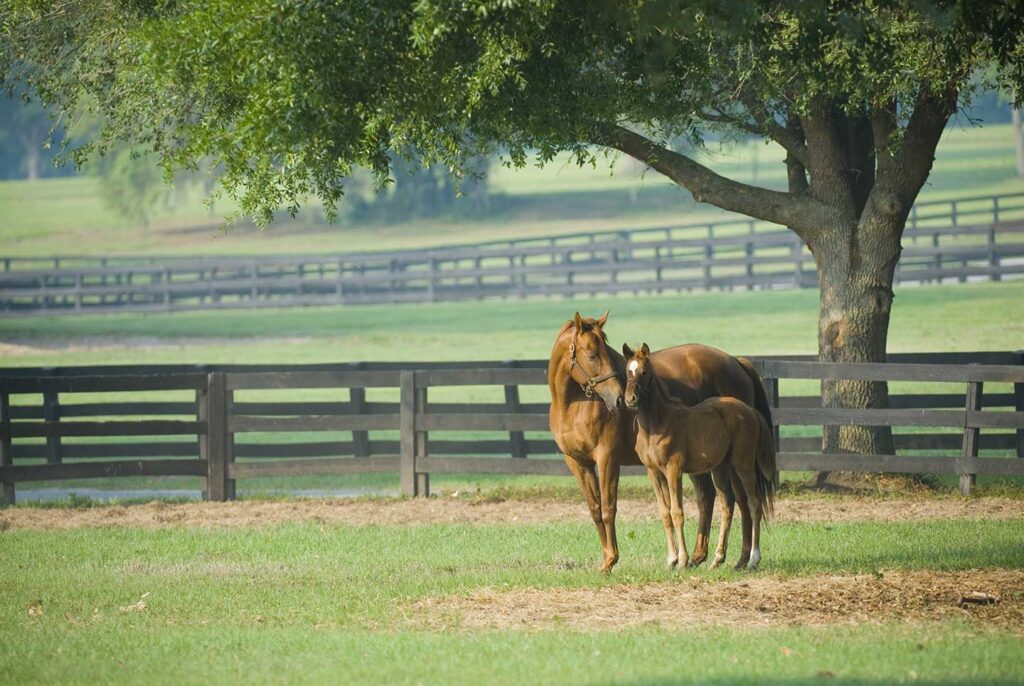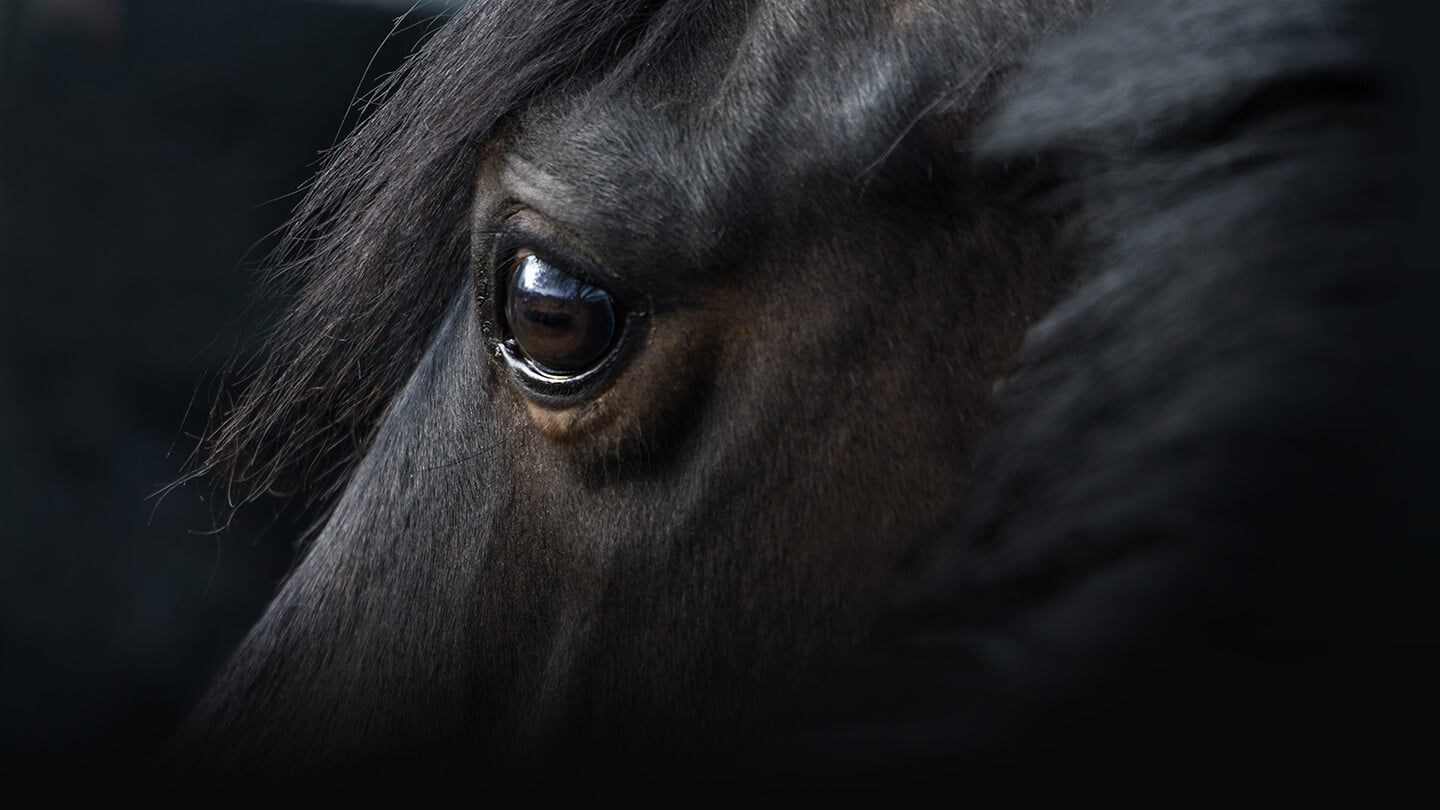Why Is Forage So Important?
 Horses have evolved as grazers, spending as much as 16-18 hours a day grazing on pasture grasses and local forages. A horse’s stomach is quite small but his hindgut is quite large, making the horse an ideal animal to ingest large amounts of fibrous material throughout each day. In fact, this fibrous material is what keeps a horse’s digestive tract healthy and functional.
Horses have evolved as grazers, spending as much as 16-18 hours a day grazing on pasture grasses and local forages. A horse’s stomach is quite small but his hindgut is quite large, making the horse an ideal animal to ingest large amounts of fibrous material throughout each day. In fact, this fibrous material is what keeps a horse’s digestive tract healthy and functional.
A horse’s hindgut is made up of the cecum, colon, and rectum. Together, the cecum and colon can hold up to 32 gallons of fibrous material, and this material slowly ferments over 2-3 days. All of the fiber a horse eats is fermented or digested, by billions of good bacteria and protozoa that live in the horse’s hindgut. These microorganisms break down the fiber a horse eats, producing volatile fatty acids that provide an important energy source for the horse. Horses can actually receive about 70% of their energy needs just from these volatile fatty acids alone!
Besides being an important energy source, the fiber in a horse’s diet is vital in keeping the horse’s digestive tract functioning like a well-oiled machine. A horse’s overall health and well-being is directly tied to the health of the bacterial population in the hindgut. When the fiber digesting microorganism in the gut are damaged or killed, they release toxins that can cause colic, founder, or hindgut acidosis. Feeding a diet rich in good quality fibers is the best way to keep a horse’s hindgut bacterial population healthy and active, and therefore keep the horse’s overall health at the best level possible. On average, mature horses need to consume 2.0-2.5% of their bodyweight in good quality fiber every day.
What Form of Fiber Is Best?
Now that we know how important fiber is in our horse’s diet, let’s look at how we can supply this dietary fiber. The most natural way for horses to receive fiber is through grazing on pasture grasses. However, due to limited space, poor quality grass or less than ideal grazing management, many pastures at today’s horse farms are used more for exercise and horse recreation rather than a means of getting nutrition into the horse. Also, changing weather condition and grass growing patterns mean that pasture grasses aren’t present all 365 days of the year. In these situations, most horse owners look to replacing pasture grass with hay.
Hay can be supplied through square bales or round bales. Square bales are smaller, easier to handle, and provide more flexible storage. However, feeding square bales can be labor intensive. Round bales, on the other hand, require much less labor as you can set them in an area and horses can eat on them for days. They are also usually less expensive on a per ton basis, but storage can be an issue and there is a potential for mold if the round bales are subjected to the elements. Perhaps the greatest drawback of round bales, however, is that horses may waste more when eating from a round bale. Because round bales are fed outside and affected by rain and mud, horses may not want to eat the entire bale. Using a specialized round bale feeder can help manage hay loss.
 Another consideration when choosing hays is grass versus legume. Grass hays can be divided into two categories: cool-season and warm-season. Cool season grasses include timothy, orchardgrass, ryegrass and fescue, while warm-season grasses include Bermuda grass (sometimes referred to as coastal or Tifton 85) and bromegrass. Legume hays include alfalfa, clover and perennial peanut hay. In general, legume hays tend to be higher in protein, energy, calcium and Vitamin A than grass hays. However, legume hays tend to be a bit lower in overall fiber content than grass hays. These attributes make legume hays an excellent option for hard working performance horses, growing horse, and breeding stock. Grass hays, on the other hand, are excellent fiber options for most mature adult horses.
Another consideration when choosing hays is grass versus legume. Grass hays can be divided into two categories: cool-season and warm-season. Cool season grasses include timothy, orchardgrass, ryegrass and fescue, while warm-season grasses include Bermuda grass (sometimes referred to as coastal or Tifton 85) and bromegrass. Legume hays include alfalfa, clover and perennial peanut hay. In general, legume hays tend to be higher in protein, energy, calcium and Vitamin A than grass hays. However, legume hays tend to be a bit lower in overall fiber content than grass hays. These attributes make legume hays an excellent option for hard working performance horses, growing horse, and breeding stock. Grass hays, on the other hand, are excellent fiber options for most mature adult horses.
The decision to feed either square or round hay bales, legume versus grass hay or a combination of both, depends on the specific management considerations of each horse owner and the horses they care for. However, no matter what form or kind of hay you choose to feed, it’s important to make sure you choose the highest quality hay possible.
Evaluating Hay
 Many people purchase their hay based on how it looks and smells, and these are actually important factors to look for when choosing hay. Ideally though, you want to look at the inside of the hay bale when determining quality, not just the outside. Good hays should be green and vibrant in color, although a slight discoloration on the outside of the bale is normal. The hay should be leafy, soft to the touch and not coarse stemmed. It should also smell fresh and not moldy or musty. High quality hays will be free from weeds, leaves, twigs, dust and other foreign material.
Many people purchase their hay based on how it looks and smells, and these are actually important factors to look for when choosing hay. Ideally though, you want to look at the inside of the hay bale when determining quality, not just the outside. Good hays should be green and vibrant in color, although a slight discoloration on the outside of the bale is normal. The hay should be leafy, soft to the touch and not coarse stemmed. It should also smell fresh and not moldy or musty. High quality hays will be free from weeds, leaves, twigs, dust and other foreign material.
Hay maturity is also a factor that determines overall quality, and you can measure hay quality by a quick visual inspection. When looking at hay, we know that most of the nutrition is in the leaf – this is where you’ll find the protein and highly digestible fibers. In young hays, there is a high leaf to stem ratio. As a plant ages, the percentage of leaves decreases and the hay will become mostly stem. A hay that is mostly stem with very little leaf content will be less digestible, and many times less palatable to the horse.
Forage Analysis
The most accurate method of determining forage quality is to have a forage analysis done on your hay. This involves taking a representative sample of the forage and sending it off to a laboratory to be chemically analyzed. A list of forage testing laboratories can be obtained from local feed companies or extension agencies. The laboratory can provide instructions on how to prepare and send your hay sample.
Once the hay sample has been tested, you will receive a detailed analysis report. At first glance, this report can be intimidating and hard to understand, but there are a few simple things you’ll want to look for to determine if your hay is providing enough nutrition to your horses. Three of the most important things to look at when examining your forage report are acid detergent fiber (ADF), neutral detergent fiber (NDF), and relative feed value (RFV).
ADF is made up of poorly digested fiber components, such as cellulose and lignin. The higher the ADF, the less digestible a hay is. Hays with ADF levels higher than 45% will have little nutritional value. NDF is a measurement of insoluble fibers, and high NDF numbers in a hay sample means a horse will want to eat less of the hay. Hays with NDF values above 65% will probably not be readily eaten by most horses. Together, ADF and NDF are used to estimate RFV. RFV was originally developed for cattle, but we can use it today to determine the expected digestibility and level of consumption of hays fed to horses. Hays with a high RFV will have higher quality, a greater intake, and be more digestible. Basically, as ADF and NDF increases, RFV will decrease. In general, an average quality hay will have an RFV of 100.
Take Home Message
Every horse owner’s goal is to meet their horses’ nutritional requirements as practically and economically as possible, and providing a good fiber base in the diet is the first step in accomplishing this task. Good quality forage can not only provide the bulk of a horse’s energy and nutrients, but horses are healthier when fed high forage diets. It’s vital that as horse owners, we spend just as much time examining and choosing our hay source as we do looking at commercial concentrates.


